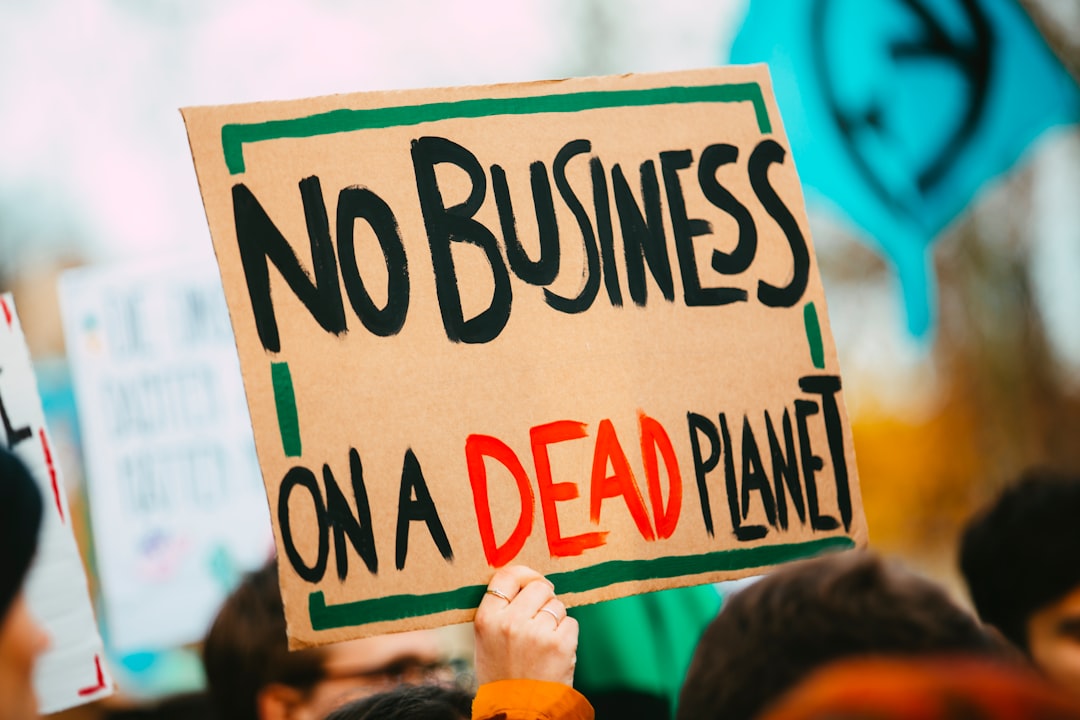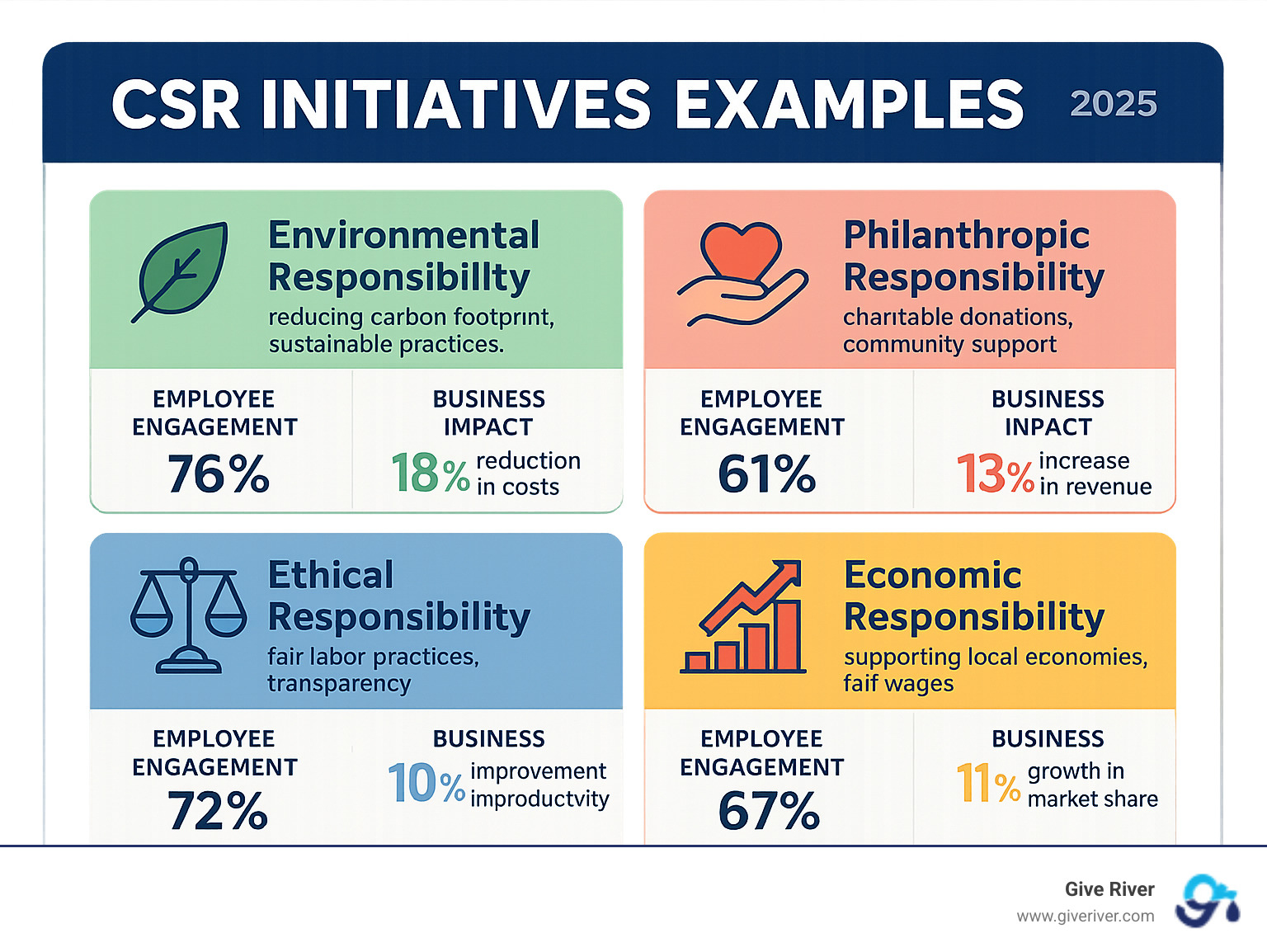See How Companies Are Doing Good: Top CSR Initiatives
Explore top csr initiatives examples from leading companies. Learn how to build your own impactful CSR program and make a difference.

Why Corporate Social Responsibility is More Than a Buzzword
CSR initiatives examples are changing how businesses operate, moving far beyond marketing tactics to become core drivers of employee engagement and organizational success. Here are the most effective types of CSR programs companies are implementing today:
Environmental Responsibility:
- Patagonia's 1% for the Planet donations
- Lego's transition to plant-based plastics
- Starbucks' 50% emission reduction goals by 2030
Philanthropic Programs:
- TOMS donating ⅓ of profits to grassroots organizations
- Salesforce's 1-1-1 model (1% product, equity, time)
- Microsoft's $4.1 billion in tech asset donations
Employee-Centric Initiatives:
- Matching gift programs (averaging $47,500 per employee annually at top companies)
- Volunteer Time Off programs (offered by 65% of companies)
- Community engagement projects led by employee feedback
The numbers tell a compelling story. 83% of consumers believe companies should actively implement ESG best practices, while companies with strong CSR leadership enjoy an 11% valuation premium over competitors. More importantly for your bottom line, 61% of Gen Z and 58% of Millennials believe they can drive change within their organization—and they're choosing employers accordingly.
But here's what many leaders miss: CSR isn't just about doing good in the community. It's about creating the kind of workplace culture that attracts top talent, reduces turnover, and drives genuine employee fulfillment. When employees see their company making a real difference, they don't just feel good about their paycheck—they feel proud of their contribution to something bigger.
I'm Meghan Calhoun, and through two decades of driving results in high-pressure environments and co-founding Give River, I've seen how meaningful CSR initiatives examples can transform workplace culture and employee engagement. The companies thriving today aren't just implementing CSR programs—they're using them as strategic tools to build healthier, more fulfilling workplaces where employees genuinely want to contribute their best work.

Quick look at csr initiatives examples:
Inspiring CSR Initiatives Examples from Leading Companies
When I see companies truly embracing corporate social responsibility, it reminds me why this work matters so much. These aren't just feel-good stories—they're csr initiatives examples that show how businesses can create real change while building stronger, more engaged teams.
The best CSR programs don't happen by accident. They emerge when leaders recognize that doing good isn't separate from doing well—it's integral to it. Whether it's protecting our planet, supporting communities, or treating employees with genuine care, these initiatives create the kind of workplace culture that attracts top talent and keeps them engaged.
Let me share some inspiring examples that demonstrate how leading companies are making this happen across different areas of social responsibility.
Environmental Responsibility in Action
Environmental responsibility is where we see some of the most innovative thinking in CSR today. Companies are realizing that sustainability isn't just about compliance—it's about reimagining how business can work in harmony with our planet.
Patagonia continues to set the gold standard here. Their 1% for the Planet program was groundbreaking, but in 2022, founder Yvon Chouinard took it to another level entirely. He transferred ownership of the $3 billion company to climate-focused entities, ensuring that all profits not reinvested would fight climate change. Their "Worn Wear" program encourages customers to repair and reuse clothing rather than buying new—a bold stance against the fast fashion model that drives their industry.

Lego proves that even toy companies can drive meaningful environmental change. They've committed $164 million to their Sustainable Materials Center and introduced 150 botanical pieces made from sustainably sourced sugarcane. By 2025, they'll eliminate all single-use plastic packaging—a massive undertaking that shows genuine commitment to long-term change.
Allbirds has built sustainability into their DNA from day one. Using renewable materials like merino wool, eucalyptus tree fiber, and sugarcane, they're proving that eco-friendly products can be both desirable and profitable. Their goal to achieve zero emissions by 2030 isn't just ambitious—it's driving innovation across their entire supply chain.
Starbucks demonstrates how large corporations can set meaningful targets. Their commitment to a 50% reduction in greenhouse gas emissions, water consumption, and waste by 2030, plus making 100% of their packaging reusable, recyclable, or compostable, shows comprehensive thinking about environmental impact.
What I love about these csr initiatives examples is how they inspire employees. When your company takes bold stands on issues that matter, it creates the kind of workplace pride that drives engagement. You can explore more about what motivates these efforts in our article on What are the Five Driving Forces of Corporate Social Responsibility?.
Philanthropic and Community-Focused Programs
The most effective philanthropic programs create meaningful connections between employees and their communities. They're not just about corporate donations—they're about empowering your team to make a difference.
TOMS pioneered the "One for One" model that distributed over 105 million pairs of glasses and shoes. But they've evolved beyond this, now dedicating one-third of their profits to "grassroots good," supporting mental health, opportunity access, and ending gun violence. This shift shows how philanthropic thinking can mature from simple giving to systemic impact.
Salesforce created something special with their "1-1-1 model"—pledging 1% of their product, equity, and employee time to philanthropic causes. This integrated approach has generated millions of volunteer hours and hundreds of millions in grants. What makes it powerful is how it weaves social impact into every employee's experience.
Microsoft demonstrates scale in action. Between July 2020 and June 2024, they trained 14.1 million people from underserved communities and donated $4.1 billion in tech assets to 375,000 nonprofits globally. They also invested $25 million in disaster relief across 16 countries, showing how corporate resources can address urgent humanitarian needs.

The most popular philanthropic programs include Corporate Matching Gifts, where companies match employee donations (top companies match up to $47,500 per employee annually), Volunteer Time Off (VTO) offered by 65% of companies, Volunteer Grants that provide monetary donations based on employee volunteer hours, and Community Giving Campaigns that organize company-wide fundraising efforts.
These programs work because they amplify individual employee passion with corporate resources. While platforms like Bonusly and Kudos are effective for peer-to-peer recognition, they often lack the dedicated features to manage and track philanthropic efforts. True community impact requires a platform that deeply integrates giving, volunteering, and recognition. At Give River, our comprehensive approach through Company Matching Gift Programs helps create these meaningful connections. For more ideas on engaging your team, explore our insights on Community Involvement Programs.
Ethical and Employee-Centric CSR Initiatives Examples
The most inspiring CSR initiatives recognize that how you treat your people is just as important as how you impact the world. Ethical responsibility creates the foundation for everything else.
Levi's shows what employee-centric CSR looks like in practice. Their Worker Well-being initiative has benefited over 100,000 workers across 12 countries since 2011, focusing on health, financial literacy, and gender equality. But here's what I find most compelling: when employees raised concerns about gun violence, Levi's didn't just listen—they launched a $1 million grantmaking fund and gave employees five paid hours monthly for volunteer work on causes they care about.
Warby Parker demonstrates how ethical operations can drive business success. Their "Buy a Pair, Give a Pair" program has distributed over 10 million pairs of glasses globally. They've scored 100% on the Human Rights Campaign's Corporate Equality Index since 2019, reflecting genuine commitment to LGBTQ+ inclusivity. Their partnerships with BIPOC entrepreneurs and focus on employee belonging prove that doing good and doing well aren't mutually exclusive.

These examples show that ethical CSR builds the kind of trust that translates into employee loyalty and customer advocacy. When your team sees that your company operates with integrity and genuinely cares about their wellbeing, it creates the foundation for the kind of engaged, fulfilling workplace culture that drives results. Learn more about creating these connections through our Workplace Giving Programs.
From Idea to Impact: Building Your Own CSR Program
The CSR initiatives examples we've explored show what's possible when companies commit to meaningful social responsibility. If you're feeling inspired to launch your own program, you're in good company—and the good news is that getting started is more achievable than you might think. The secret isn't having a massive budget; it's approaching CSR strategically and weaving it into the fabric of who you are as an organization.
Key Steps for Implementing Your CSR Strategy
Building a CSR program that actually makes a difference starts with thoughtful planning. Here's how to turn your good intentions into real impact:
Align with Purpose should be your first priority. The most successful CSR programs feel authentic because they connect directly to what your company already stands for. When your social responsibility efforts flow naturally from your mission and values, they resonate more deeply with employees and customers alike. A tech company might focus on closing the digital divide, while a food business could tackle hunger relief or food waste. This alignment isn't just about optics—it creates genuine passion and buy-in from your team.
Stakeholder Feedback transforms your CSR program from a top-down initiative into something your entire community owns. Don't assume you know what matters most to your people. Survey your employees, talk to your customers, and engage with your local community. 61% of Gen Z and 58% of Millennials believe they can drive change within their organization—so give them that opportunity! When people help shape the program, they become its champions.
Set Clear Goals that you can actually measure. Vague aspirations like "help the environment" won't cut it. Instead, aim for specific targets: "reduce our office waste by 25% this year" or "complete 500 volunteer hours as a team." Many companies find it helpful to align their goals with the United Nations Sustainable Development Goals, which provide a comprehensive framework for addressing global challenges.
Start Small and build momentum. You don't need to revolutionize the world on day one. Begin with manageable projects that match your current resources and capabilities—maybe a monthly volunteer day, a simple matching gift program, or partnering with one local nonprofit. Success breeds success, and these early wins will give you the credibility and experience to expand your efforts over time.
Measure Success both in numbers and in hearts. Track the tangible stuff—dollars donated, volunteer hours logged, pounds of waste diverted—but don't forget the intangible benefits like employee morale, team cohesion, and brand reputation. These softer metrics often prove to be your most valuable outcomes. For deeper insights into developing effective programs, explore our guide on Charitable Impact Strategies.
The Role of Technology and Employee Engagement
Here's what many companies find the hard way: managing CSR initiatives manually becomes a nightmare as you grow. Without the right systems, you'll find yourself drowning in spreadsheets, struggling to track who volunteered where, and completely unable to show the real impact of your efforts. Employee participation drops when the process is clunky, and leadership loses confidence when they can't see clear results.
This is where employee-driven initiatives supported by technology become game-changers. The best CSR platforms make it incredibly easy for your team to find volunteer opportunities, submit matching gift requests, track their personal impact, and even suggest new causes worth supporting. When participation is simple and rewarding, engagement soars.
CSR platforms do the heavy lifting of streamlining efforts across your entire organization. They automate the administrative tasks that used to consume hours of HR time—managing volunteer sign-ups, processing donation matching, generating impact reports, and keeping everyone informed about upcoming opportunities. This automation frees your team to focus on strategy and relationship-building rather than paperwork.
The magic happens when you add gamification elements that make giving back genuinely fun. Leaderboards, achievement badges, and social sharing features turn CSR participation into a positive team experience. While platforms like Bonusly or Kudos excel at peer-to-peer recognition, they often stop there. A comprehensive CSR platform goes further by creating direct connections between employee fulfillment and tangible community impact.
At Give River, we've seen how our unique 5G Method transforms CSR from a nice-to-have into a cornerstone of workplace culture. By integrating recognition, wellness, growth, gamification, and community impact, we help companies create programs where every volunteer hour and every donation is celebrated and amplified. This holistic approach ensures that doing good becomes part of your team's DNA, not just another corporate initiative.
For companies serious about measuring and communicating their impact, technology becomes essential. Learn more about effective tracking and transparency in our article on What is Corporate Social Responsibility Reporting?. You'll also find valuable insights about employee engagement through our Company Matching Gift Programs guide.
Conclusion: Making an Impact with Your CSR Program
The CSR initiatives examples we've explored—from Patagonia's environmental leadership to Salesforce's integrated giving model—prove that corporate social responsibility isn't just about checking boxes or improving optics. It's about creating workplaces where people feel genuinely proud to contribute their talents toward something bigger than themselves.
CSR as a Strategic Advantage becomes clear when you look at the numbers. Companies with strong CSR programs enjoy better brand reputation, increased customer loyalty, and significantly higher employee retention rates. With 80% of today's workforce caring deeply about their employer's social impact, a thoughtful CSR program becomes your secret weapon for attracting and keeping top talent in a competitive market.
Fostering Culture through social responsibility creates something special—a sense of shared purpose that transforms how teams work together. When employees can make a difference through their workplace, it builds pride, strengthens relationships, and gives everyone a reason to bring their best selves to work each day. This isn't just about employee fulfillment; it's about creating organizations that people genuinely love being part of.
At Give River, we believe that happier, healthier, high-performing teams are built through meaningful connections—to each other, to purpose, and to community impact. Our 5G Method makes it simple for companies to weave social responsibility into the daily experience of work, turning every good deed into a building block for stronger workplace culture.
The future belongs to purpose-driven organizations. By embracing CSR thoughtfully and systematically, your company can contribute to a better world while open uping deeper employee commitment and sustainable business success.




